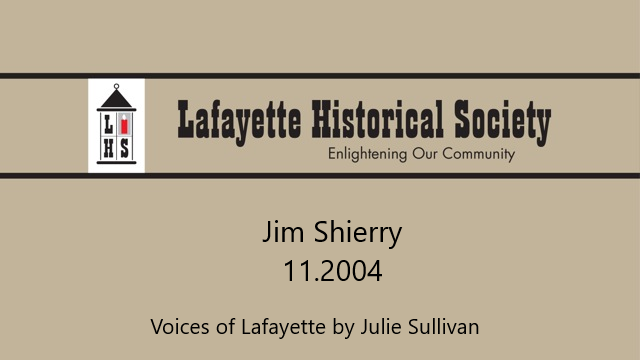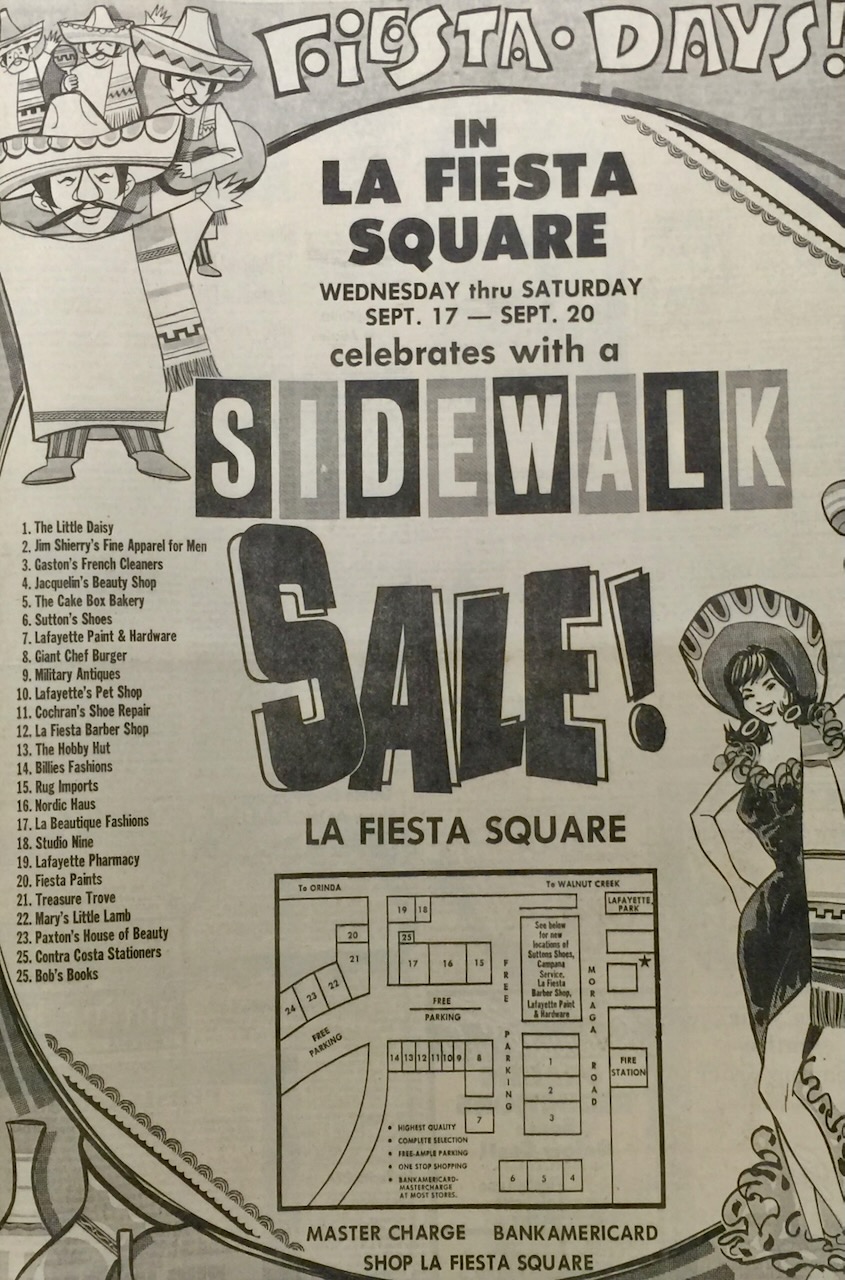Summary:
Jim Shierry was interviewed by Julie Sullivan in November, 2004. Jim learned the clothing business at an early age by working alongside his father, who was a manufacturer’s rep. After serving in the Army Air Corps during the Second World War he decided to open his own clothing store, Shierry Men’s Apparel, in La Fiesta Square. He correctly predicted that this growing community would need a place for businessmen to buy their suits and accessories. Jim discusses what it was like to be in business in Lafayette in the period from 1947 to 1972.
Oral History:
To hear Jim Shierry tell it, pure chance brought him to Lafayette. It was 1945, just before he was discharged from the Army Air Corps. “I flipped a coin to decide whether to go back on the road (as a manufacturer’s rep) or open a men’s store in Lafayette,” he says. That coin flip resulted in Shierry’s Men’s Apparel, which opened in 1947 and was a vital part of the business community for more than twenty-five years. At age 90-plus, Jim’s eyesight isn’t as good as it used to be, but his memory is razor sharp. He still lives in the house he built himself just off Reliez Valley Road.
“When you’re traveling on the road all over Northern California, you see towns building along, growing up and scratching. With the tunnel and people moving out this way, I figured Lafayette would have to grow up some time,” Jim remembers.
Jim, who was born in Cedar Rapids, Iowa in 1913, is an only child. His family moved to San Francisco when he was ten. Jim and his mother later lived in St. Paul, Minnesota, Philadelphia and Los Angeles. After Jim graduated from high school in 1932, he and his mother joined his father, Ed, a manufacturer’s rep, in Oakland.
“I kind of tagged along with my father as a manufacturer’s rep. I was perhaps the youngest fellow on the road,” he remembers. “It was better than working inside warehouses where it was dark and dingy, and you earned fifteen or sixteen dollars a week. Carpenters back then just got a raise to sixty cents an hour. Levis sold for $16.25 a dozen, and I could open a sample room in the St. Francis Hotel in San Francisco for two days, and the total cost, including setup, was four dollars per day. I drove a 1930 Ford Town Sedan I paid two hundred twenty-five dollars for. I sold it and bought a brand new Plymouth for six hundred forty-five dollars.”
Jim’s first store was on Mt. Diablo Boulevard where One Hour Martinizing is now. “I had to take the only store that was open, because there were very few buildings in town, and at the end of the war there was not much construction going on, because materials were not available,” he explains. “After two years, I moved directly across the street where Radio Shack is today. I stayed there for three years until Claudio Garibotti built a new building on Moraga Road. It was next to Sutton’s Shoes and the grocery, just across the street and down from Joe Campana’s music store. I stayed there for twenty-two years until I closed the store around 1974.
“At the end of the war, there were very few manufacturers that had excess merchandise,” Jim remembers. “They didn’t have any goods to cut up and make into clothing, and they didn’t want any new accounts, particularly we coming out of the service. They didn’t cater to us at all. I had some help from my father, Ed. I started out with twenty pairs of men’s pants that retailed for twelve dollars each. I sold Pendleton shirts for six dollars and forty-five cents. I originally carried Rough Rider, Arrow and Pendleton, then later on I carried higher-priced merchandise.
“I worked six days a week from 9:00 a.m. to 6:00 p.m. My wife, Gladys, used to bring me lunch, because there were no restaurants open for lunch in town. After six months, I was able to hire an employee.”
Jim and Gladys met at McClellan Field in Sacramento, and they were married while he was in the service. Gladys, a former accounting teacher, worked as Jim’s bookkeeper. She passed away in 1982. Jim’s son, Arthur, lives in Wyoming and Florida. His two daughters, Paula and Leslie, live in the Bay Area. Jim has three grandchildren and one great granddaughter.
“My first store was probably twelve feet by forty feet. I occupied half the building next to a delicatessen. You should never build a men’s store next to a deli,” he says with a laugh, “because you get too much garlic odor. We opened in early fall, 1947. I had hats, pants, sports shirts, knit shirts and ties. There were no suits. You couldn’t get suits. No shoes.
“Back then the Lafayette Emporium was my only competition. They had both men’s and women’s clothes. It was run by Peters’ shoe store in Oakland. The Emporium was on Mt. Diablo and kind of wrapped around the drug store and liquor store where Starbucks is now. Next door was Mickey Meyers’ grocery.
“You had to work to sell anything when I started out,” he says. “Personal trade was how the business grew. I tried to buy the best lines particular to California regardless of price, so my store was a high-priced store. All the lines I used to carry are gone today. You don’t hear of Roth Clothing any more. I had two long term employees, Stan Soder and Jack Kish. After I was in business six months, I had my own tailor who did piece work for me.”
Jim’s parents, who moved to Victoria Avenue in Lafayette in 1937, built a guest house on their property. “They rented it to cadets at the flight training school at St. Mary’s College during the war. During my last year in the service, my wife, our son and I moved in. I added a bedroom, since it was only one room. We lived there for the first two years after I opened the store. I was finally able to get a loan to buy a lot and build a house. We built what I call half a house, only about seven hundred square feet, the minimum under the building code, on three- quarters of an acre. We were the first house on a brand new street off Reliez Valley Road. I took nine years to build the rest of the house, including the swimming pool. Today it is over 3,000 square feet.
“I would go home after lunch and work on adding to the house until dark, or I’d get up at sunrise, work on the house, then go work in the store from lunch time till closing. I put in six hours every day enlarging the house.”
After Jim’s store was open about five years, realtors began urging him to move to Walnut Creek, because it was growing faster than Lafayette. Jim, a member of Rotary for twenty years, was happy in Lafayette. “Our business was highly competitive. When Kaiser opened its world headquarters in Oakland, it brought top management to Orinda and Walnut Creek. They were looking for something, and I was happy to provide it for them.” Jim opened a second store on Hartz Avenue in Danville, which he closed after twelve years in 1973.
“The business climate for our Lafayette store changed when Sutton’s Shoes was destroyed in a fire (1968),” Jim acknowledges. “When those stores burned out, my business went down quite a bit, because people thought my store had burned, too. Traffic also disrupted parking. Lafayette was not as inviting to run a business in. Rents went up. What really changed the whole area was when Sun Valley Mall opened.
“Lafayette never grew up properly,” Jim feels. “They never should have been allowed to build that box where World Savings (now Wachovia) is located.”
When his business was declining, Jim found the open spaces in Jackson Hole, Wyoming. In 1972 he started building a campground and RV park in a former cow pasture there. Jim ran the campground six months a year. He kept his home in Lafayette, because his wife was ill and couldn’t leave. After six years, he sold the campground to his son, Art. Art and his wife have been running it since then. “Today the homes around there run from $1 million up to $19 million, and there are dozens of them,” Jim adds.
Jim has lots of memories from his sixty years of living and working in the Lafayette area. “If you go down on Golden Gate Way (south of Mt. Diablo Road) that was the main road through town. Where Coral Pool Supply is today there was a hamburger stand. I remember it when we used to drive out here from Oakland for picnics.
“Where the David M. Brian store in Walnut Creek is today used to be Penney’s. Woolworth was across the street. Then Smith’s and Grodin’s moved in. Both of them were working men’s stores.
“Lafayette used to have a good horse show. I remember kids riding horses inside the Roundup Saloon. And the town hall used to have a dirt floor. Kyle Watson managed the appliance store that Matt Connley and his brother-in-law owned. The Marlowe Arms apartments behind the current Petar’s restaurant were built by Russ Bruzzone and Lowrey.
“Sun Valley Lumber was owned by Elmo Lombardi. He moved it across Mt. Diablo Boulevard, where the property was occupied by Western Sand and Brick. It was kind of an eyesore to have a big elevator for mixing sand and gravel right out in front. Today it’s the Lafayette Park Hotel.
“One of the biggest changes in Lafayette are the stop lights. We only had one originally, and the freeway originally had no central turnoff for Lafayette. That changed when BART came into town.
“One of the funniest things I remember was when the Methodist Church on Moraga Road put in a new public address system. After midnight one night, someone broke in and began playing the same song over and over, as loud as the system could play. It took quite a while to get it turned off, because they also took all the knobs off the doors.”
Excerpted from “Voices of Lafayette” by Julie Sullivan. This book is available for purchase in the History Room.



Leave a Reply